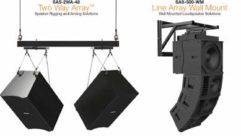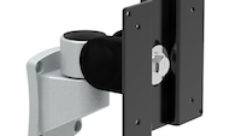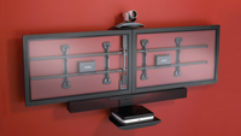
Technology Showcase:
Flatscreen Wall Mounts
Aug 1, 2006 12:00 PM,
By Jay Ankeney
Modern articulating units meet high standards and solve major installation challenges.
Ergotron 45-194
Today’s wall mounts for large-format flatscreen displays are all about ergonomics and physics. With the growing popularity of wall mounts relying on articulated arms to hold displays ranging from 32in. monitors to more than 100in. monsters, ergonomic considerations are pushing the physics of a modern mount’s installation to the limit. After all, large LCD or plasma screens cost as much as a car and weigh more than the luggage it carries, and hanging that valuable piece of technology on the end of an arm stretching a couple of feet from the wall involves considerable torque factors.
Even the ancient Greek, Archimedes, who is credited for the famous “Eureka” exclamation, noted that the amount of force applied to an extended object, called the moment of force, is defined as M = rF, where F is the applied force and r is the distance from the applied force to object. But don’t take his word for it. Just try holding a phone book at arm’s reach for a couple of minutes. Then, multiply that by the weight of a 60in. plasma display over its predicted 60,000 hours of installed life.
Fortunately, many wallmount manufacturers have stepped up to the challenge with a variety of clever designs for reliably suspending flatpanel displays — especially if professional AV contractors install the mounts. Since competitive pricing has limited profit margins on the sales of the large flatpanel displays, installing a sophisticated wall mount can be a lucrative part of a respected installer’s contract.
Most people trying to hang an old-fashioned CRT display opt for strapping that picture tube onto shelving alternatives due to the old-form TV’s weight and bulk, which precludes most tilting or swiveling options. But over the past decade, the call has arisen to freely swing newer LCD or plasma display screens in a conference room, training facility, retail sales space, or worship hall, and that has resulted in three basic designs. The first is a low-profile design, which sits nearly flat against the wall and generally can tilt the display; the second is articulating, with several combinations of pivoting arms; and the third is full motion, which provides maximum positioning and rotation possibilities.

OmniMount 63HDARMUA
HIGH STANDARDS
VESA, the Video Electronics Standards Association, with 140 worldwide members, has been going to considerable effort to develop standardized mounting hole patterns for LCD and plasma displays, with the goal of enabling screens from multiple manufacturers to accomodate the same wall-mount designs. In addition to empowering reliable installation procedures, VESA’s Flat Display Mounting Interface (FDMI) standard also means that a mount purchased to hold today’s LCD or plasma screen will be able to accommodate tomorrow’s display designs. Recently announced enhancements to the FDMI have revised the standard to accommodate new generations of flat displays 90in. or larger, measured diagonally.
Many manufacturers have purchased the VESA FDMI standard and implemented it into their products so they can call themselves VESA compliant. However, only companies that have provided product specifications to VESA and paid the licensing fee can display the VESA logo on their product packaging and marketing materials. They are listed in the “Companies Earning the VESA Mounting Compliance Logo” section of the VESA website (vesa.org).
Although VESA has produced mounting hole standards for both LCD and plasma displays, far more of the liquid crystal screen manufacturers have adopted those standards than their gas-tube counterparts. Because LCD screens started out smaller and were therefore easier to mount on a wall, it seems their proponents incorporated the VESA standards more readily. Plasma displays, which reached large-screen dimensions earlier with heavier hardware, have been slower to jump on the VESA bandwagon. As a result, mount manufacturers have developed a spectrum of Universal Plasma Mounts (also called Universal Interface Brackets) that can be tailored by professional installers to accommodate even the largest plasma screens.
Underwriters Laboratory will also put its “UL” seal of approval on flatpanel wall mounts by evaluating specific mounts, along with each particular display they are intended to hold. The display and mounts are certified under “Audio/Video Apparatus” (called AZSQ), using UL 60065 mechanical strength requirements for the mounts. Wall and ceiling mounts are covered under “Carts and Stands for Household, Commercial and Professional Use” (CZUV), using UL 1687 requirements.
A newly proposed UL 2442 standard, containing expanded content that addresses state-of-the-art features found in currently available mounts, will be made available for public comment starting this month. UL 2442 will also deal with future considerations, such as the ability to provide motorized movement after installation, built-in illumination, onboard AC outlets, glass panels, flammability, and thermal insulation, among other factors.
When hanging an expensive large-format flatpanel display on a wall, installers will also want to make sure the system stays firmly in place, even when the ground beneath it does not. Although intended mostly for hospital and nursing facility installations, organizations such as the California’s Office of Statewide Health Planning and Development (OSHPD), part of the California Health and Human Services Agency, have come up with specifications detailing seismic security requirements for wall mounts holding screens weighing more than 20lbs., and most manufacturers comply with them. Keeping in mind the considerable torque exerted from an extended moment arm, nobody wants to wear that expensive flatpanel display as a hat.

Innovative Office Products 7000 series
LOTS OF OPTIONS
Even as LCD and plasma displays expand to unprecedented size and weight, a growing number of manufacturers are offering flatpanel wall mounts with various forms of articulating arms to keep viewers comfortable in whatever environment the mounts are installed in.
Chicago-based Bretford is a third-generation family-owned business that launched its new line of AV mounts at InfoComm this year. Its OSHPD-approved Gibraltar series wall mounts meet 2001 California building code standards, section 1632A, and EASE (Equipment Anchorage and Seismic Engineering) has tested them to an 8.0 magnitude earthquake level. Bretford’s FPLM-ARM-AL adjustable arms universal flatpanel wall mount can hold screens up to 50in. in size with 40-degree tilt adjustment, and it revolves easily between portrait and landscape orientation (0-degree to 15-degrees pitch adjustment in landscape view). The FPLM-ARM-AL mount has flexible cable management in its dual articulating arms and a universal mounting plate for both LCD and plasma screens. It comes with a 12-year warranty.
Currently being distributed in North America by Rocelco, the B-Tech International line of flatpanel wall mounts with dual articulated arms includes the BT8412 for plasma and LCD screens between 21in. and 50in. The universal LCD mounting plate includes VESA-compatible mounting patterns of 200mm×200mm, 200mm×100mm, 100mm×100mm, or 75mm×75mm.
A Universal Interface Bracket is included with the BT8412 for plasma and non-VESA LCD screens. For bigger displays, the B-Tech BT8432 is a UL-approved flatpanel wall mount for screens up to 61in. and weighing 150lbs. The tilt mechanism, based on B-Tech’s original BT1 speaker wall mount from 1979, is continuously adjustable up to 15 degrees, up or down. A significant feature of the B-Tech mounts is the heavy-duty modular construction system, which means all components are interchangeable, so you can easily customize any mount for your exact application.
In 2004, Chief acquired Sanus Systems to form Chief/Sanus Audio Visual, but since they present themselves to the market as two separate companies, we’ll deal with Chief here and Sanus later. Chief’s CM1-W18, which just started shipping last month, is an automated flatpanel mounting arm designed for flatpanel TVs up to 61in. and weighing up to 170lbs., and it features three programmable pre-set viewing positions. Capable of being recessed between 16in. center studs, Chief’s CM1-W18 extends 18in. from the wall and swivels +/-50 degrees.
It comes with either universal or custom mounting brackets, and Chief’s exclusive Q-Latch mounting system ensures increased security with a locking flag and provides easy disconnect/reconnect of the screen. Chief’s PAC-500 large in-wall swing arm accessory can hold flatpanel TVs up to 65in. or up to 200lbs. These swing-arm mounts include a channel on the underside or topside of the arm that holds the cable in place. All Chief mounts include integrated cable management for a clean installation.
Da-Lite has been making display mounts for many years, but this year, the company brought out its first models fitting the VESA 75mm and 100mm patterns — the Articulating VESA Mount (VSM-AR1 and VSM-AR2), with 11in. and 20in. extensions, respectively. Both the VSM-AR1 and VSM-AR2 will accommodate up to a 40in. diagonal screen and, depending on the monitor, will support up to 40lbs. The Da-Lite VSM-AR1 and VSM-AR2 are available in a gray or black powder finish, and they come with a five-year warranty.

Rhino Mounts FPM 2200
The PWM-AA articulating wall mount for flatpanel displays from Display Devices is a rugged, dual-arm design that can be recessed into walls or cabinetry. It comes in three versions to accommodate 37in. to 61in. displays. The PWM-AA can hold up to 150lbs. with its heavy-duty construction for large weight loads, while measuring less than 3in. deep. In addition, Display Devices provides a Motorized Rotating Wall Mount (MRWM) that can present flatpanel displays up to 50in. in either landscape or portrait orientation. Inside the MRWM, cables pass through the central hub for easy management. Display Devices also offers an optional continuous rotating option (IMRCM) that continually rotates in one direction and provides positional feedback for content management.
The WH 3D (formerly the Aero 3Dimension for plasma displays) wall mount from Draper includes its exclusive SMS Universal Plasma bracket, which can hold 50in. plasma displays, weighing 100lbs., up to 26in. from the wall. With the WH 3D, you can pull the screen out, move it left to right, and tilt it forward (up to 10 degrees), in any combination. Draper also makes a smaller mount for LCDs, the WL 3D LCD wall mount, which can extend 15in. from the wall, holding a 22lb. display. VESA-compliant, the WL 3D’s arm allows +/-90 degrees of rotation and +/-25 degrees of tilt.
One of Draper’s more unique designs is the ST800, which can hold up to three LCD screens suspended from a column mounted on a wall with cable management inside the column. Displays can be mounted on either side of the column so they are directly opposite each other, yet they afford +/-90 degrees of rotation and +/-25 degrees of tilt. For even more strength, Draper’s WHF-ST2000 model features a 78in. extruded aluminum column, which attaches to the wall and floor with a sturdy steel swivel.
Embedded CF (Constant Force) technology lets the Neo-Flex HD wall mount swing arm from Ergotron hold 32in. flatpanel displays weighing up to 50lbs., 13in. out from a wall with effortless adjustment. The Neo-Flex HD has been tested to four times its maximum weight capacity as per UL Standard 1678, and can present the monitor in either portrait or landscape orientation. If you need to mount a larger 61in. display, weighing up to 175lbs., Ergotron’s Tilting Wall Mount has been engineered for exceptional stability and also features integrated CF motion technology. Designed to be VESA compliant, the screen on Ergotron’s Tilting Wall Mount can be angled with fingertip ease, and includes security fasteners to deter others from removing the display.
Innovative Office Products considers its 7000 series of flatpanel mounts its bread-and-butter product with more than 100,000 currently in use. Using gas-assisted radial arms, the screen, held by a 7000 series mount, seems to float in space without a ratcheting mechanism, and its Flexmount technology provides six mounting options, including attaching the screen to a wall or clamping it to a desk.
Since the arms come with different strength gas cylinders, the heaviest duty model can hold screens more than 30in., weighing up to 44lbs. The arm is triple articulated, so it can be completely folded back upon itself to save space. Innovative Office Products also offers the VESA-compatible 9110 LCD/LCD TV wall mount for large flatpanel displays weighing up to 45lbs. The 9110 has 4in. and 8in. extension arms available that can be combined to increase extension up to 12in.
Lucasey’s FSWA2216 flatpanel wall mount for 26in. to 32in. displays was initially designed for the Four Seasons hotel in New York. The screen on the FSWA2216 extends up to 15in. out from the wall and glides into position thanks to patented spring-loaded adjustable arms that counterbalance the weight of the flatscreen for free-floating movement. Its four individual articulating arms allow for a wide range of motion.
Lucasey also has the FSWA2220 flatpanel mount that can accommodate up to 42in. plasma screens. The adapter plate required for the FSWA series mounts can use either Lucasey’s VESA mounting pattern adapters, or FSUL universal landscape adapters.
The professional line from OmniMount includes the 63HDARMUA, which can hold a 63in. screen, weighing 200lbs., up to 28in. from the wall thanks to its new CL-X dual-arm Wishbone cantilever mount. OmniMount’s 63HDARMUA uses a UAL universal self-centering adapter that positions itself in the center of even the widest flat display automatically. In addition to the adapter’s wide range, from a VESA-compliant 1100mm×100mm to 335mm, this ensures that the 63HDARMUA can accommodate nearly every large flatpanel display on the market today. To securely hold that load, the CL-X incorporates all-alloy I-beam arms unique to the industry and relies on six holes, instead of the conventional four, for attaching it to the wall.

Vogel EFW 6245
Originally founded to support World War II wartime production, Peerless Industries has been making AV mounting accessories since the 1940s. In the ’50s, the company began manufacturing rabbit-ear television antennas, and in the ’60s, it introduced the first Peerless television mount, model 1100, for Zenith TVs in the hospitality market. This year, its new PLA series will feature Peerless’ first dual-arm articulating wall mount with the largest in the series — the PLAV70 — intended to hold screens measuring up to 71in. and 200lbs. The PLAV70 benefits from self-lubricating bushings that enable the arms to smoothly reach up to 2.5ft. into the room with a 180-degree pivot and a simple knob mechanism can fine tune the mount’s tilt +10 degrees/-5 degrees.
At the end of last month, Peerless launched its first remote-controlled design — the Peerless Automated Mount model MM860 — that can extend 12in. and then pivot left and right and tilt up and down before retracting to a mere 4in. The MM860 comes with a universal remote control that can also be programmed for the TV’s operations and has two to four presets to swing the display into pre-determined positions. It also has an RS-232 port that can be connected to a Crestron or AMX automated control system.
Premier Mounts’ top-selling AM2 line is VESA-75mm/100mm/200mm×100mm compatible, enables 180-degree left and right swing and 360-degree screen rotation with a 3.5in to 17in. extension from the wall. Recommended for 17in. to 40in. LCD displays, the AM2 flatpanel wall mounts feature Premier Mounts’ patented Radial Glide technology, which offers smooth tilt adjustment of +/-15 degrees, and an innovative system of cable management ports. Most significantly, it comes with a lifetime guarantee.
For non-VESA compatible displays, the AM2-150 includes the UFP-150 adapter plate, which can be made to fit any new LCD screens that have unique mounting patterns. For larger flatpanel screens, including plasmas, Premier Mounts’ AM3 line, which was just launched at this year’s CES, can hold displays from 40in. to 61in. The AM3 comes with a lifetime guarantee.
Rhino Mounts has the distinction of being the only flatpanel mount sold on the QVC channel. Its FPM 2200 articulating arm mount fits displays from 26in. to 42in. with a total extension of 37in. from the wall and 180-degree swivel capability. For the largest of screens, Rhino Mounts’ FPM 4000 model can hold 65in. to 120in. flatpanel displays thanks to its solid-steel construction.
But what really sets Rhino Mounts apart is its industry-leading warranty, which reads in part, “Rhino Mounts will repair or replace up to a maximum of $10,000.00, at its option, any component (television, projector, or monitor) which is damaged by a Rhino Mounts mount’s failure to perform* when that product is properly installed** for its intended use.” There are, of course, conditions as indicated by the asterisks, but this is one company that aggressively stands behind its products.
Sanus offers a complete line of flatpanel wall mounts featuring either the patent-pending Virtual Axis fingertip tilting system or SmoothLock tilt and swivel, each using tapered bearings that allow the viewer to position the display with the push of a finger. The VisionMount model VMDD26 wall mount from Sanus can hold plasma displays up to 84in. with dual articulating arms that pivot around three swivel points, enabling extension up to 25.75in. from the wall. The VMDD26 mount can be rotated +/-6 degrees after installation, so the display will appear perfectly level. Sanus also features the VisionMount model VMAA26 for LCD and plasma screens from 30in. to 50in., with a redesigned hinged arm that enhances the mount’s appearance. All VisionMount models feature heavy-gauge steel and extruded aluminum construction for strength, and come in either silver or black.
The AX2AWL01 articulating wall mount from Vantage Point incorporates a unique design for leveling the monitor in any position it is placed, up to 5 degrees rotation left or right. Offering articulation both at the wall and monitor, the AX2AWL01 mount permits 5 degrees upward tilt and 15 degrees downward tilt to provide a precise viewing angle. The mount extends 18.5in. from the wall for 18-degree side-to-side viewing, depending on the size of the monitor, and the extended arm is designed to completely disappear behind the monitor when it is pushed back to the wall. Although the AX2AWL01 is VESA compliant for 27in. to 45in. LCD screens, Vantage Point also offers the ADP42 universal mounting bracket for plasmas up to 42in. Vantage Point also produces the model AXUL02 for flatpanel displays, a double-arm mount product to fit many applications beyond walls, including under a cabinet, on desktops, and inside RVs.
Just this month, Video Mount Products (VMP) is bringing out its first plasma display mount, the PDM-W. It’s an articulating design universal mount that fits screens ranging from 37in. to 63in., and provides an 180lb. load capacity. The PDM-W features maximum adjustability, a -5-degree to +20-degree tilt capability, and a 24in. reach when its arms are fully extended. For 25in. to 37in. LCD displays, Video Mount Products calls its LCD-2537 model a multi-configurable mount because it can be used as a single-arm, double-arm, or near-flush mount. That’s because the LCD-2537 articulates with three different pivot points rotating 240 degrees at the monitor, 240 degrees at the elbow joint (double-arm configuration), or 160 degrees at the wall. It also benefits from a feed-through wall plate with decorative cover and includes a clip-based cable management system.
Euro design styling distinguishes the flatpanel wall mounts made by Vogel’s Products, which is now a part of the Audiovox. Vogel’s Evolution 6000 series mounting system includes its three Optimally Adjustable models: the EFW 6145, EFW 6245, and EFW 6345, which can hold screens from 14in. to 42in., weighing from 6lbs. to 99lbs. All three can be pulled out from the wall, turned a full 60 degrees left and right, and tilted 15 degrees forward and backward for easy viewing and virtually unlimited freedom of movement.
Vogel’s Adjustable model line of mounts can be pulled forward and turned 20 degrees left and right and tilted for optimal viewing. For the largest displays, Vogel’s flat/fixed models create the traditional flat look and can support screens up to 65in. wide while leaving room behind the display for adequate air circulation.
Bretford
www.bretford.com
For More Information
B-Tech International
www.hi-fidelity.com
Chief
www.chiefmfg.com
Da-Lite
www.da-lite.com
Display Devices
www.displaydevices.com
Draper
www.draperinc.com
Ergotron
www.ergotron.com
Innovative Office Products
www.lcdarms.com
Lucasey
www.lucasey.com
OmniMount
www.omnimount.com
Peerless Industries
www.peerlessmounts.com
Premier Mounts
www.mounts.com
Rhino Mounts
www.rhinomounts.com
Sanus Systems
www.sanus.com
Vantage Point
www.vanptc.com
Video Mount Products
www.videomount.com
Vogel’s Products B.V.
www.vogels.com









